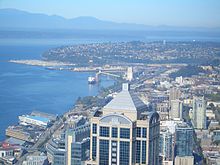

Smith Cove (formerly known as "Smith's Cove") is a body of water, the northern part of Seattle, Washington's Elliott Bay, immediately south of the area that has been known[1] since 1894[2] as Interbay.[1] More precisely, it is the part of the bay that lies north of a line running southeasterly from the west end of Elliott Bay Marina in the northwest to the far northwest tip of Myrtle Edwards Park in the southeast.[citation needed]
It is home to the Port of Seattle's Piers 90 and 91, in addition to the marina.[1]
The cove was named after Dr. Henry A. Smith of Wooster, Ohio, who, in 1853, was one of the first whites to settle in what is now Seattle. It was briefly a candidate to be the heart of the emerging city.[1] The cove and its tide flats once stretched as far north as what is now the Interbay Athletic Field. James J. Hill bought 600 acres (2.4 km2) of these tide flats in 1892 and had them filled in for the western terminal of the Great Northern Railway. At one time, the terminal included a switchyard, roundhouse, grain elevators, and warehouses as well as piers for oceangoing ships.[3] Today, the rail yards of the BNSF Railway remain, as does the aforementioned athletic field. Other present-day features on landfill in what was formerly the cove are the Interbay Golf Center[citation needed] and the Washington Army National Guard Armory.[4]
- ^ a b c d David Wilma, Seattle Neighborhoods: Interbay -- Thumbnail History, HistoryLink, July 2, 2001. Retrieved 11 July 2008.
- ^ BOLA Architecture et al., p. 11. Page numbers in citations from this document follow the document itself: the PDF page numbers are greater than this by 2; e.g. page 11 is PDF page 13.
- ^ Florence K. Lentz and Mimi Sheridan, Queen Anne Historic Context Statement Archived 2010-06-07 at the Wayback Machine, prepared for the Seattle Department of Neighborhoods, Historic Preservation Program and the Queen Anne Historical Society, October 2005, p. 9. Retrieved 24 July 2008.
- ^ BOLA Architecture et al., p. 14.